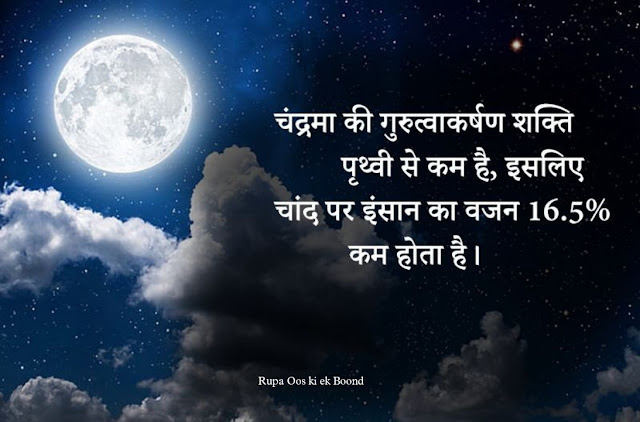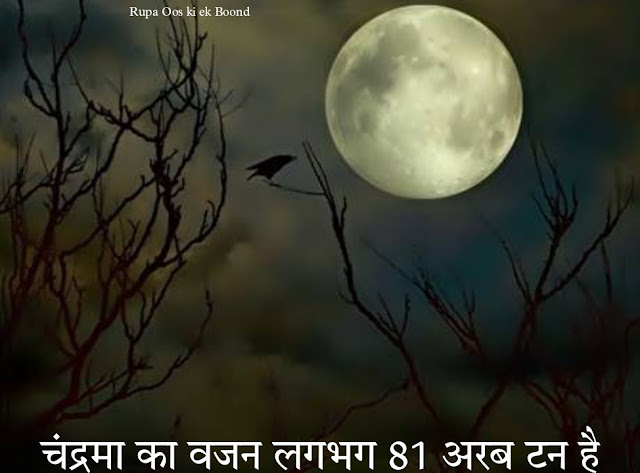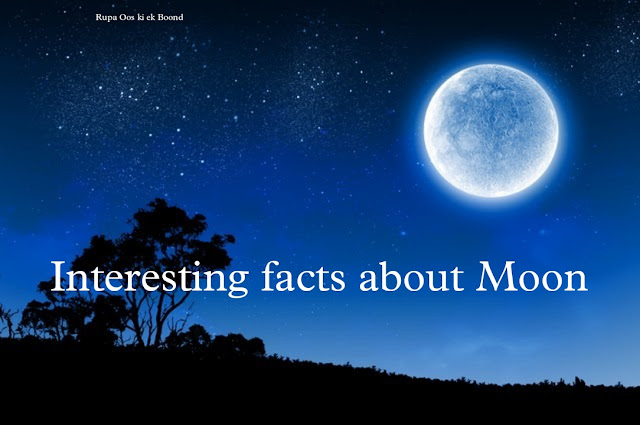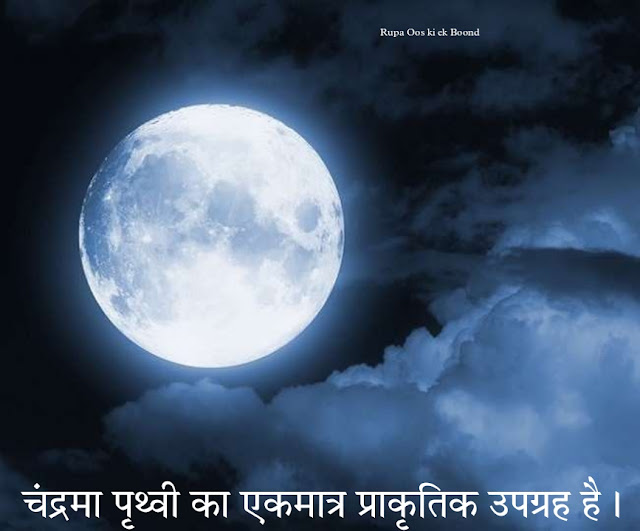चांद के बारे में रोचक तथ्य
बचपन से हम चांद को आसमान में देखते आ रहे हैं, और इससे जुड़ी किस्से कहानियों को सुनते आ रहे हैं। परंतु कई ऐसे तथ्य हैं, जिनसे हम अनजान हैं, तो आइए जानते हैं आज चंद्रमा के बारे में कुछ आवश्यक और रोचक तथ्य-
- चंद्रमा पृथ्वी का एकमात्र प्राकृतिक उपग्रह है। सौरमंडल के 181 उपग्रहों में यह पांचवा सबसे बड़ा उपग्रह है।
- पृथ्वी से देखने पर चंद्रमा गोलाकार नजर आता है, किंतु वास्तव में इसका आकार अंडे के समान है अर्थात् अंडाकार है।
- नासा के अपोलो 40 मिशन के दौरान एकत्रित किए गए लूनर रॉक्स के सैंपल का अध्ययन कर वैज्ञानिकों द्वारा पता लगाया गया कि चंद्रमा लगभग 4.51 बिलियन वर्ष पूर्व अस्तित्व में आया।मंगल ग्रह के बराबर एक थिया(thia) नामक चट्टान लगभग 4.5 अरब वर्ष पूर्व पृथ्वी से आकर टकराई थी। इस टकराव के फलस्वरुप चंद्रमा का निर्माण हुआ था।
- चंद्रमा का व्यास 3476 किलोमीटर है, जो पृथ्वी के व्यास का लगभग 1/4 है चंद्रमा का आकार बृहस्पति और शनि के उपग्रहों से भी छोटा है।
- चंद्रमा का वजन लगभग 81 अरब टन है।

- जिन उपग्रहों के घनत्व ज्ञात हैं, उसमें चंद्रमा दूसरा सबसे अधिक घनत्व वाला उपग्रह है। पहले स्थान पर बृहस्पति का उपग्रह आयो (lo) है।
- चंद्रमा को पृथ्वी का चक्कर लगाने में लगभग 27.3 दिन का समय लगता है।
- चंद्रमा 2300 मील/घंटे (3700 किलोमीटर/ घंटे) की औसत गति से पृथ्वी की परिक्रमा करता है।
- चंद्रमा और पृथ्वी के बीच की दूरी लगभग1,3 8,900 मिल (3,84,000किमी) है।
- हालांकि चंद्रमा रात में चमकता दिखाई पड़ता है, लेकिन उसका स्वयं का कोई प्रकाश नहीं होता वह सूर्य के प्रकाश से प्रकाशित होता है। यह प्रकाश पृथ्वी तक पहुंचने में 1.3 सेकंड लगते हैं।

- चंद्रमा का गुरुत्वाकर्षण पृथ्वी के गुरुत्वाकर्षण का मात्र छठा हिस्सा है, इसका अर्थ यह हुआ कि चंद्रमा पर किसी व्यक्ति का भार पृथ्वी की तुलना में 1/6 होगा। वजन कम होने के कारण चंद्रमा पर कोई भी व्यक्ति बहुत ऊंची छलांग लगा सकता है।
- गुरुत्वाकर्षण शक्ति कम होने के कारण चंद्रमा पर वायुमंडल नहीं है। इसका अर्थ यह है कि चंद्रमा ब्रह्मांडीय किरणों, उल्कापिंडों और सौर हवाओं से असुरक्षित है। यहां तापमान में भी बहुत भिन्नता पाई जाती है।वायुमंडल की कमी के कारण चंद्रमा पर कोई आवाज नहीं सुनी जा सकती है,और यहां से आकाश हमेशा काला दिखाई पड़ता है।
- चंद्रमा दिन के समय अत्यंत गर्म और रात में अत्यंत ठंढा होता है। यहां दिन का औसत तापमान 134 डिग्री सेल्सियस और रात का -153 डिग्री सेल्सियस रहता है।
- चंद्रमा प्रतिवर्ष पृथ्वी से लगभग 3.8 सेंटीमीटर दूर होता जा रहा है। अनुमान है कि यही क्रम लगभग 50 बिलियन वर्षों तक जारी रहेगा। उस स्थिति में चंद्रमा को पृथ्वी की परिक्रमा करने में 27.3 दिनों के बजाय लगभग 47 दिन लगेंगे।
- पृथ्वी से देखने पर सूर्य और चंद्रमा दोनों एक ही आकार के दिखाई पड़ते हैं, लेकिन वास्तव में चंद्रमा सूर्य से 400 गुना छोटा है। सूर्य की तुलना में पृथ्वी से 400 गुना करीब होने के कारण चंद्रमा आकार में सूर्य जितना प्रतीत होता है।
- हमेशा चंद्रमा का एक ही भाग पृथ्वी के सामने होता है, ऐसा इसलिए है क्योंकि चंद्रमा के अपने अक्ष पर घुर्णन की अवधि और पृथ्वी की कक्षा में परिक्रमा की अवधि एक समान है, इसलिए हम हमेशा चंद्रमा का 50% भाग देख पाते हैं।
- आधे चांद की तुलना में पूरा चांद 9 गुना अधिक चमकदार होता है।
- यदि चंद्रमा ना रहे तो पृथ्वी पर दिन मात्र 6 घंटे का होगा।

- चंद्रमा का क्षेत्रफल अफ्रीका के क्षेत्रफल के बराबर है।
- पृथ्वी सूर्य और चंद्रमा की पारस्परिक कुर्ता कैसे शक्ति की क्रियाशीलता के कारण समुद्र में ज्वार भाटा उत्पन्न होता है।
- चंद्रमा पर सर्वप्रथम पानी की स्थिति की खोज भारत द्वारा की गई वर्ष 2008 में चंद्रयान मिशन में चंद्रमा पर बर्फ के रूप में पानी के अस्तित्व की खोज की गई जिसकी पुष्टि नासा द्वारा भी किया गया।
English Translate
interesting facts about moon
Since childhood, we have been seeing the moon in the sky, and listening to stories related to it. But there are many such facts, which we are unaware of, so let us know some important and interesting facts about the moon today-
- The Moon is the only natural satellite of the Earth. It is the fifth largest satellite among the 181 satellites of the Solar System.
- The Moon appears spherical when viewed from Earth, but in reality its shape is like an egg, that is, oval.
- By studying samples of lunar rocks collected during NASA's Apollo 40 mission, it was discovered by scientists that the Moon came into existence about 4.51 billion years ago. had come and collided. The Moon was formed as a result of this collision.
- The diameter of the Moon is 3476 km, which is about 1/4 of the diameter of the Earth. The size of the Moon is smaller than the satellites of Jupiter and Saturn.
- The Moon weighs about 81 billion tons.
- Among the satellites whose densities are known, the Moon is the second most dense satellite. In the first place is Jupiter's satellite Io (lo).
- It takes about 27.3 days for the Moon to orbit the Earth.
- The Moon orbits the Earth at an average speed of 2300 miles/h (3700 km/h).
- The distance between the Moon and Earth is approximately 1,3 8,900 mil (3,84,000 km).
- Although the moon appears to shine at night, it has no light of its own, it is illuminated by sunlight. This light takes 1.3 seconds to reach the Earth.

- The Moon's gravity is only one-sixth that of Earth's, which means that the weight of a person on the Moon would be 1/6 that of Earth's. Due to the low weight, one can jump very high on the moon.
- The Moon does not have an atmosphere because of its low gravitational force. This means that the Moon is vulnerable to cosmic rays, meteorites and solar winds. There is also a lot of variation in temperature here. Due to the lack of atmosphere, no sound can be heard on the moon, and from here the sky always looks black.
- The Moon is extremely hot during the day and very cold at night. The average day temperature here is 134 °C and night time is -153 °C.
- The Moon is moving away from Earth by about 3.8 cm every year. It is estimated that this sequence will continue for about 50 billion years. In that case the Moon would take about 47 days instead of 27.3 days to orbit the Earth.
- When viewed from Earth, both the Sun and the Moon appear to be the same size, but in reality the Moon is 400 times smaller than the Sun. Being 400 times closer to the Earth than the Sun, the Moon appears to be about the same size as the Sun.
- Always the same side of the Moon is in front of the Earth, this is because the period of rotation of the Moon on its axis and the period of revolution in Earth's orbit is the same, so we always see 50% of the Moon.

- The full moon is 9 times brighter than the half moon.
- Without the Moon, the day on Earth would be only 6 hours.
- The area of the Moon is equal to the area of Africa.
- The tidal ebb in the sea is generated due to the interaction of the Earth, the Sun and the Moon.
- The existence of water on the Moon was first discovered by India in the Chandrayaan mission in 2008, the existence of water in the form of ice on the Moon, which was also confirmed by NASA.




Intresting 👍👍
ReplyDeleteक्या बात है आजकल पोस्ट पर चांद ही चांद...
ReplyDeleteबहुत ही अच्छी जानकारी
ReplyDeletevery nice
ReplyDeleteRupa in Cyclopedia
ReplyDelete22 वा बस मुझे पता है
ReplyDelete👍👍
ReplyDeleteवैज्ञानिक दृष्टिकोण से चंद्रमा के सम्बंध में 21 रोचक बातें बताने के लिए धन्यवाद । आप की खासियत यही है कि आप विज्ञान और अध्यात्म में सामंजस्य बैठाकर काफी उपयोगी बातें हमलोगों तक पहुंचाती रहती हैं जिससे हमलोगों को काफी कल्याणकारी जानकारी प्राप्त होती रहती है 🙏जी आपका हृदय से आभार🙏
ReplyDeleteबहुत रोचक जानकारी।
ReplyDelete👌👌👌✌️✌️👏👏👏
ReplyDeleteWonderful news. It's so romantic.
ReplyDeleteचंद्रमा के कुछ तथ्यों से बिलकुल अनजान था। आज का ब्लॉग पढ़कर चंद्रमा की अहमियत का भी पता चला।
ReplyDeleteअच्छी और ज्ञानवर्धक जानकारी
दिलचस्प
ReplyDeleteबेहद सुंदर और चमकदार जानकारी ✌🏻
ReplyDeleteBahut rochak jankari...wakai me jo chand humlogo ke liye itna mahatwpurn hai...usse humlog anbhigya hain..aisi aisi jankariyon se blog ke pathkon ko awagat krane ke liye aapka dil se abhar...
ReplyDeleteWow सभी topic पर पकड है 👍
ReplyDeleteInteresting.
ReplyDelete